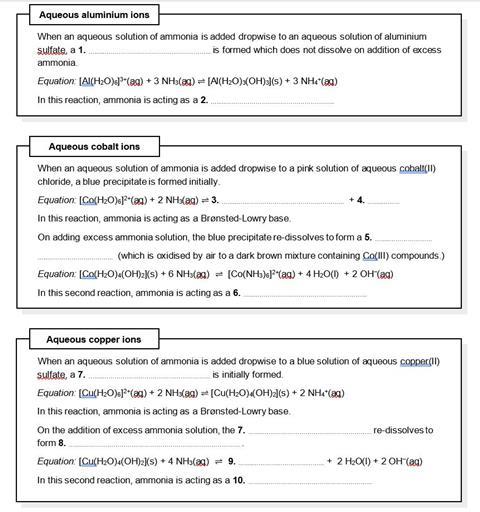A question and answer sheet that tests learner’s knowledge of inorganics in aqueous solution
The topics covered in this Starter for ten are: acid base chemistry, BrØnsted-Lowry and Lewis bases, ligand substitution reactions, inference from aqueous tests.
Example questions
For each of the test tube reactions described below;
(a) Write a balanced symbol equation (including state symbols) for the reactions occurring,
(b) Describe what you would expect to observe.
1. Sodium hydroxide solution is added dropwise to an aqueous solution of copper(II) sulfate until present in excess.
Equation
Observations
2. Sodium hydroxide solution is added dropwise to an aqueous solution of iron(II) sulfate until present in excess.
Equation
Observations
3. Sodium carbonate solution is added dropwise to an aqueous solution of manganese(II) sulfate until present in excess.
Equation
Observations
4. Sodium carbonate solution is added dropwise to an aqueous solution of iron(IIl) chloride until present in excess.
Equation
Observations
5. Sodium hydroxide solution is added dropwise to an aqueous solution of chromium(III) sulfate until present in excess.
Equation(s)
Observations
A Brønsted-Lowry base is a proton acceptor. A Lewis base donates a pair of electrons.
In each of the test tube reactions described below, ammonia acts either as a Brønsted-Lowry base or a Lewis base. Complete the descriptions by filling in the blanks labelled 1-10

Notes
A full version of this question and answer sheet is available from the ‘Downloads’ section below. An editable version is also available.
Downloads
Inorganics in aqueous solutions - editable
Word, Size 0.22 mbInorganics in aqueous solutions
PDF, Size 0.33 mb
Starters for 10: Advanced level 2 (16–18)

This chapter in our Starters for ten series covers: kinetics, equilibria, acids and bases, carbonyl chemistry, aromatic chemistry, compounds with amine groups, polymers, structure determination, organic synthesis, thermodynamics, periodicity, redox equilibria, transition metal chemistry, and inorganics in aqueous solution.
- 1
- 2
- 3
- 4
- 5
- 6
- 7
- 8
- 9
- 10
- 11
- 12
- 13
- 14
 Currently
reading
Currently
reading
Inorganics in aqueous solution















































No comments yet